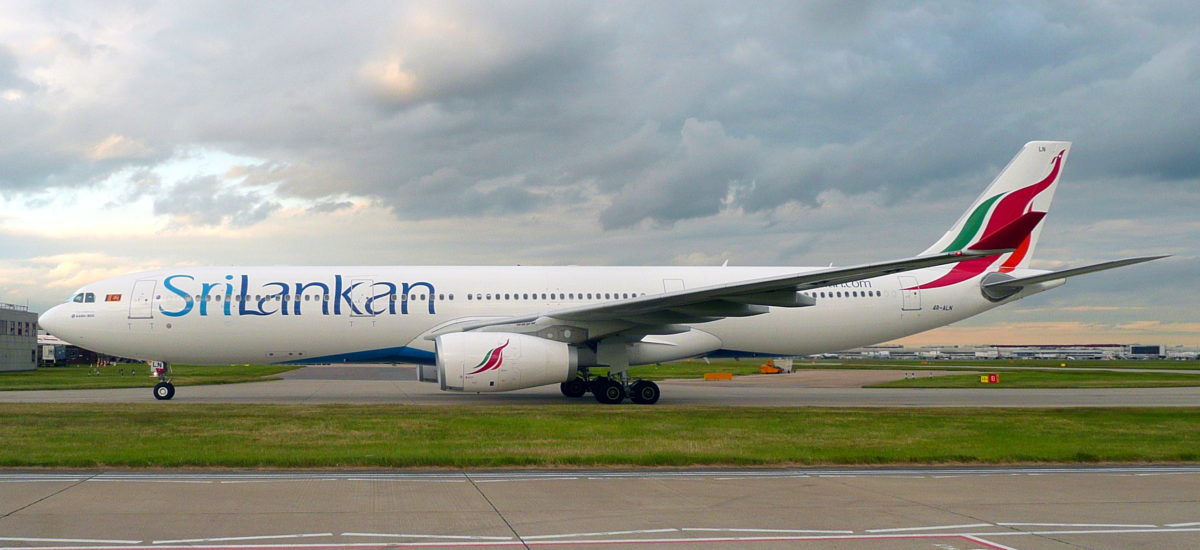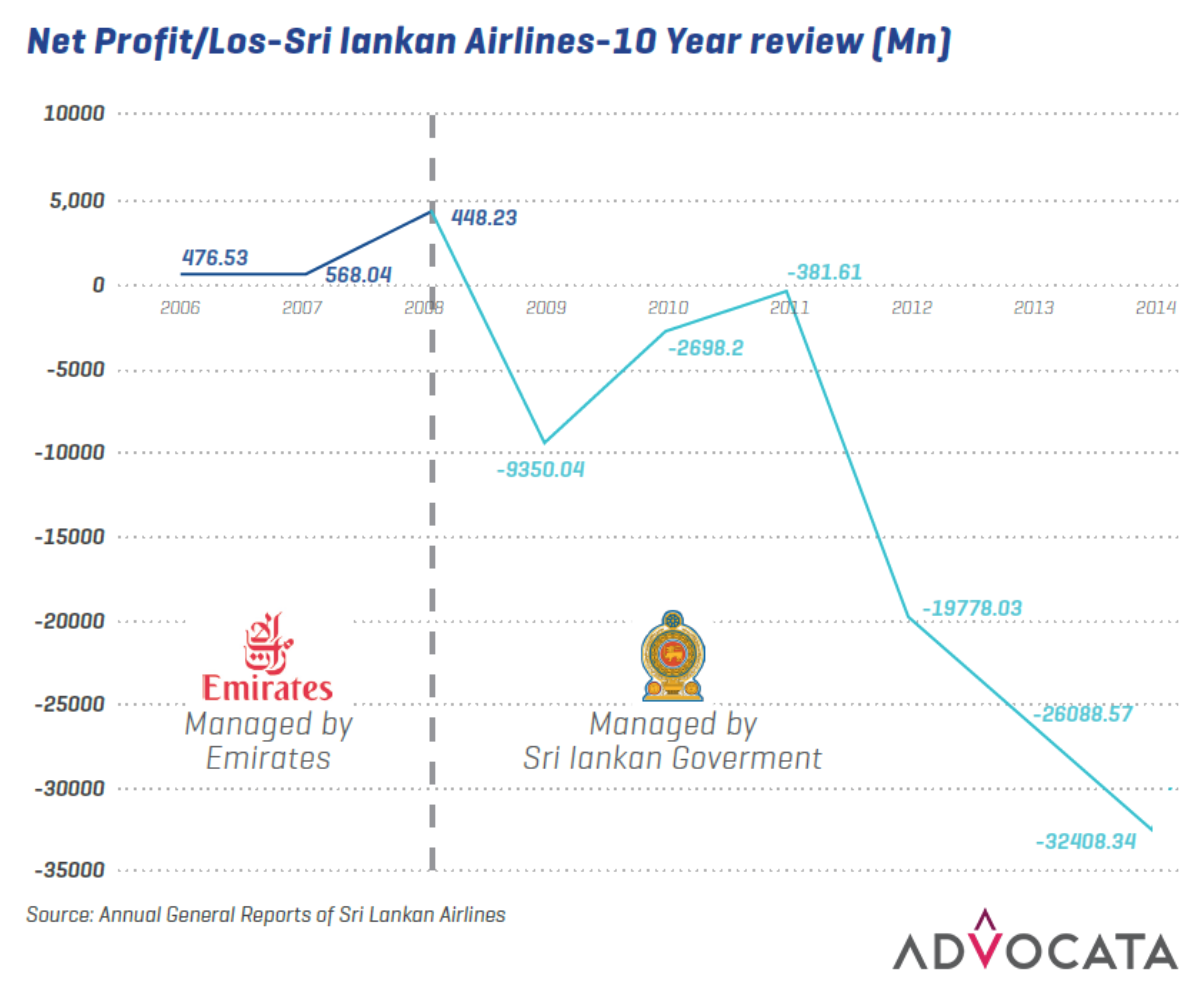A couple of weeks ago, Prime Minister Ranil Wickremesinghe announced that the debts of SriLankan Airlines, amounting to a mammoth US$ 3.2 billion, will have to borne by the taxpayer. He said the government is taking this action to defuse an economic ‘landmine’ and that his government is actively looking for an international partner to manage the airline.
When a three billion dollar bill is passed on to ordinary Sri Lankans, many of whom have never flown the airline, it’s worth examining what let do this disastrous situation. In examining the data, it’s clear that Srilankan Airlines provides an excellent example of the problems that arise from state-owned enterprises.
Air Lanka, the state-owned airline was privatised in April 1998. The government of Sri Lanka sold a 40% shareholding to Emirates Airlines, which was also contracted to manage the company for a period of 10 years. The government of Sri Lanka continued to retain the majority shareholding but management was relinquished to Emirates.
Emirates re-branded the airline as ‘SriLankan’, overhauled the airline’s infrastructure and adopted a new approach to its operations. Cost-effective strategies were introduced; new pro-active management teams were put in place; Information technology became the basis of everyday activities. The airline’s network was constantly reappraised and product enhancement became a part of the airline’s philosophy. The airline was completely re-fleeted with an all-Airbus fleet of A340, A330 and A320 aircraft replacing the ageing Lockheed Tristars.
Although the privatisation and restructuring attracted a lot of criticism at the time, the exercise was eventually deemed a success; indeed in many quarters it was hailed as model for other airlines.
At an international seminar on airline restructuring and privatisation, held a couple of years after the divestment; the President of the employees union of Srilankan spoke on how union rights were protected and the improvement of working conditions.
At the time of the privatisation all employees were gifted shares by the government based on the number of years of service. Although a voluntary retirement scheme was also implemented the President of the union stated that employees were given an excellent deal if they wanted to leave and no-one was made redundant. Collective Agreements signed by the airline with employee unions guaranteed increments to employees. New human resource development programmes were instituted after privatisation to upgrade employees’ skills and a new grade and pay structure put in place.
Union representatives from other state-owned airlines were also impressed by the manner in which the airline disclosed information to employees; “they had never seen such transparency from an airline’s management,” said K J L Perera president of the employees union. SriLankan published its quarterly financial results in its staff newsletter.
Following a spat in December 2007 the Chief Executive Peter Hill, had his work permit revoked.The dispute began when Hill refused to bump 35 passengers from a full London-Colombo flight to make way for Sri Lanka’s president and his entourage. The Government cancelled the work permit of the CEO of the airline and in March 2008, Emirates did not renew the management contract. The airline, which had been consistently profitable under the management of Emirates last reported a profit in 2008; a bumper Rs.4.4bn. Since then the airline has racked up enormous losses; according to the latest published accounts for the year ended March 2015 losses stood 123.26bn rupees.
The airline reported an operating loss of Rs.16bn in the year 2015, an improvement from the loss of Rs.31.3bn in 2014. To put these figures into context, the Government bought out Emirates for only US$53m (or Rs.7bn at today’s exchange rate). Last year alone the airline lost four times its original purchase price, a truly remarkable feat. The airline’s accumulated losses amount to almost a billion dollars; the entire Southern highway was built for around 700 million dollars, cost overruns included.
The management of the airline has claimed that the recession in Europe and high oil prices caused the losses. The public was urged to look beyond the “mere profitability aspect” and understand the “catalyst role played” by the airline in tourism; in the words of the former CEO.
Airlines are global businesses and the same factors affect all airlines. Singapore Airlines cited by many who try to justify state ownership of airlines reported a marginal operating loss in only a single year during the last ten years; a loss of US$38m in 2009/10.
Singapore airlines is no less affected by the recession and oil prices, but it did not report losses. Singapore Airlines is a well-run state airline that is something of an exception. Many cite it’s example but few have been able to emulate its success, so we should not try to justify our Government’s ownership by looking to Singapore. Srilankan Airlines own track record is what we need to examine.
What changed when the Government took it over? They inherited a profitable business with the same staff, systems and infrastructure; the principal difference was in the management. The truth is that the airline suffered from gross mismanagement and corruption, some of which has recently been uncovered.
These problems seem to plague state owned enterprises (SOE’s), but why do they occur?
There are two elements to explanation: the principal-agent problem and the free-rider problem, both based on the assumption of self-seeking individuals.
An SOE is run by managers who do not own the firm. In a firm under state control managers know that their salaries will be paid regardless of how the business performs, therefore there is no incentive to maximise efficiency.
Frequently in Sri Lanka the Government will be under pressure to appoint various loyalists to key positions. In some, (although not all) instances, those who seek political patronage to be ‘fixed up in a job’ are people who lack the skills or abilities to find a job on their own merits. Thus the enterprise may become stuffed with incompetents; good staff will find it very difficult to work with these people so they either leave or give up trying to do any work and concentrate on keeping in the good books of the bosses.
The maxim of “more work, more trouble, less work, less trouble and no work, no trouble” is applied. In any case pay and benefits are not dependent on performance, so why bother to stick ones neck out? Soon, this attitude poisons the enterprise and staff work on surviving in their jobs rather than trying to manage the business.
This problem would not exist if the citizens, who are the owners (principals) of SOEs, can perfectly monitor the SOE managers (their agents) but individual citizens do not have the incentive, and means, to monitor the SOE managers.
This leads to the second element of the problem, even if they did try to hold the SOE to account, the costs that an individual citizen incurs in monitoring SOE managers (obtaining and analysing financial information, seeking explanations through public channels etc.) are solely his or hers, while the benefits of improved management accrue to all owners. Time and effort will be expended in the exercise by the citizen who receives no immediate benefit. Thus, individually, the citizens have little incentive to monitor the SOE managers, which means that in the end, no one monitors them. This is the so-called free-rider problem.
This is the fundamental structural flaw with SOE’s which explains why many operating in truly competitive markets are doomed to failure. There are apparently profitable SOE’s but In some instances they operate as a monopoly, like the Sri Lanka Port Aunthority. In other instances such as LakSathosa, Governments may create an uneven-playing field in markets where an SOE competes with private firms, as they have a vested interest in ensuring that state-owned firms succeed. LakSathosa is exempt from the VAT and NBT charged on other supermarkets giving them a significant competitive advantage.
Accordingly, despite its role as regulator the government may, in fact, restrict competition through granting SOEs various benefits not offered to private firms. In such instances SOE’s may appear to be profitable but this is due to hidden subsidies and distortions which are ultimately borne by taxpayers.
Airlines used to be regarded as a key part of transport infrastructure, like roads or bridges, which should be owned by the Government. Until the mid-1980s, most governments did own airlines and protected flag-carriers by restricting new entrants. This thinking has changed.
Privatisation made air travel more competitive and liberalisation brought competition from low-cost carriers. Most airlines in state control have failed to adapt and are losing money. There is little strategic interest in owning an airline; Switzerland and Belgium have done without a flag carrier for years.
The airline is currently a huge drain on the treasury and the previous experience with Emirates demonstrates the clear benefit of privatisation.
###
Ravi Ratnasabapathy is a Management Accountant by training and a fellow at the Advocata Institute, a new independent policy think tank launched recently in Sri Lanka. A version of this article appeared on Advocata’s inaugural publication titled “The State of State Enterprises in Sri Lanka”. The publication can be read and downloaded for free on the Advocata Institute website.


